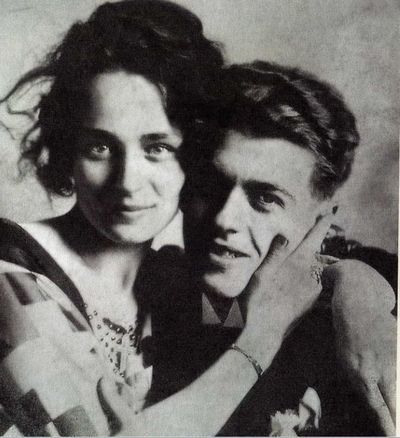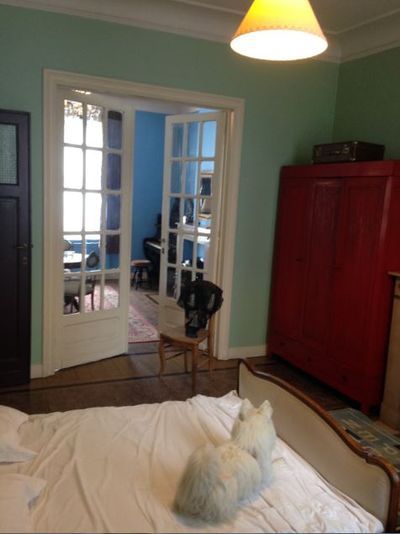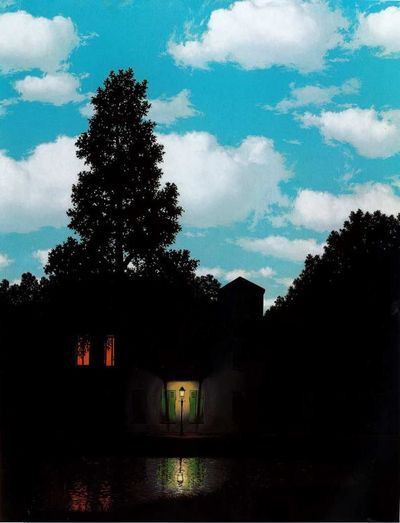Two Magrittes

Georgette and Ren�� Magritte on their wedding day, June 22, 1922
By ADRIAN TAHOURDIN
The Ren�� Magritte Museum in the Jette suburb of Brussels should not be confused with the Magritte Museum in the city centre. This famously playful artist would surely have appreciated the potential for confusion this near-doubling up offers. The first was opened in 1994, the second only in 2009. Magritte might also have been tickled by the fact that the second museum forms a part of the Mus��es Royaux des Beaux-Arts de Belgique ��� he flunked out of the Acad��mie Royale des Beaux-Arts when a student.
After some years moving in Brussels' Surrealist circles in the 1920s (he was born in 1898), Magritte and his wife Georgette moved to Paris where they stayed for three years. Although he fraternized with the French Surrealists, it was characteristic that Magritte should have elected to keep his distance from them ��� setting up home in a villa in Perreux-sur-Marne to the east of the city. This conventional m��nage earned the scorn of French Surrealism���s bully boy Andr�� Breton. When, one evening, he expressed surprise at seeing Georgette wear a cross on a gold chain around her neck, and suggested it should be thrown away or replaced by a piece of wood, it was the final straw. Georgette is said to have stormed out of the room followed by an equally furious Ren��. (It���s worth noting that Ren�� himself was rarely, if ever, photographed out of a jacket and tie, but that doesn���t make him any less of an original or remarkable artist.)
The couple returned to Brussels in 1930 and rented an apartment at 135 Rue Esseghem in the tranquil suburb of Jette (it now sits under a flight path). They lived there from 1930 to 1954, during which time the artist sold little, and yet produced some 800 works (half his output). In 1954, at Georgette���s request, the couple moved into a bigger apartment in the town of Schaerbeek outside Brussels, where they remained until Rene���s death in 1967.
The ground floor of the house in Jette has been restored to as near a resemblance to its appearance in Magritte���s time as possible. Visitors peer into the rooms over a glass partition door. The upper three floors (which we are required to don shoe covers to access) were separately occupied when Ren�� and Georgette lived in the building. The downstairs rooms convey an atmosphere of slightly bizarre cosiness; the sky blue wall paint in the sitting room seems rather Magrittean, as does the bright red wardrobe. And there���s one of the couple���s Pomeranians, stuffed and positioned on the bed (they had no children but six dogs of that breed). In the small dining room/studio Magritte worked and met his Surrealist friends, with whom he also larked about in the garden ��� much of it captured on Magritte���s Super-8 films, which can be seen in the main museum. The house was, effectively, the headquarters of Belgian Surrealism for two decades.
In the garden meanwhile is the studio which Magritte built himself and where he did much of his commercial work, such as graphics and posters, including for the Belgian national carrier Sabena; he called the space ���Dongo���, after the main character in Stendhal���s novel The Charterhouse of Parma, Fabrizio del Dongo.
The upper floors of the house contain an extensive collection of Magritte���s drawings, lithographs and the odd painting. It���s all well worth seeing, and when I went I was the only visitor until the doorbell heralded a party of eight whose arrival sent the staff of four into a vague panic.
As for the Mus��e in the city centre, arranged on three floors it houses the most extensive collection of Magritte���s work anywhere in the world, including of course that most mysterious and unsettling work, "The Empire of Lights" (1954, above, detail). How gratifying it was to see there Brussels primary schoolchildren being introduced to this beguiling and unfathomable artist. I wonder what they made of him.
Peter Stothard's Blog
- Peter Stothard's profile
- 30 followers





